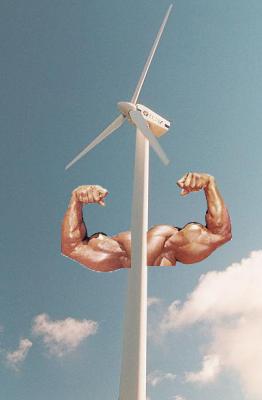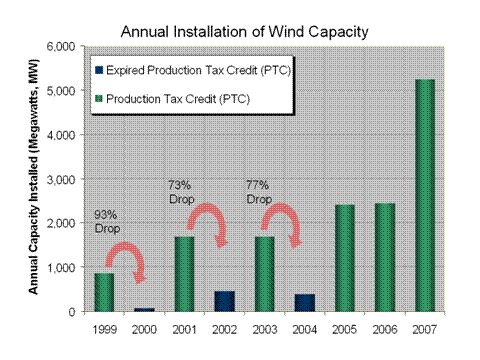 Shattering all its previous records, the U.S. wind energy industry installed 5,244 megawatts (MW) in 2007, expanding the nation’s total wind power generating capacity by 45% in a single calendar year and injecting an investment of over $9 billion into the economy, the American Wind Energy Association (AWEA) announced today. The new wind projects account for about 30% of the entire new power-producing capacity added nationally in 2007 and will power the equivalent of 1.5 million American households annually while strengthening U.S. energy supply with clean, homegrown electric power.
Shattering all its previous records, the U.S. wind energy industry installed 5,244 megawatts (MW) in 2007, expanding the nation’s total wind power generating capacity by 45% in a single calendar year and injecting an investment of over $9 billion into the economy, the American Wind Energy Association (AWEA) announced today. The new wind projects account for about 30% of the entire new power-producing capacity added nationally in 2007 and will power the equivalent of 1.5 million American households annually while strengthening U.S. energy supply with clean, homegrown electric power.
“This is the third consecutive year of record-setting growth, establishing wind power as one of the largest sources of new electricity supply for the country,†said AWEA Executive Director Randall Swisher. “This remarkable and accelerating growth is driven by strong demand, favorable economics, and a period of welcome relief from the on-again, off-again, boom-and-bust, cycle of the federal production tax credit (PTC) for wind power.â€
“But the PTC and tax incentives for other renewable energy sources are now in danger of lapsing at the end of this year—and at the worst moment for the U.S economy,†added Swisher. “The U.S. wind industry calls on Congress and the President to quickly extend the PTC—the only existing U.S. incentive for wind power—in order to sustain this remarkable growth along with the manufacturing jobs, fresh economic opportunities, and reduction of global warming pollution that it provides.â€
The U.S. wind power fleet now numbers 16,818 MW and spans 34 states. American wind farms will generate an estimated 48 billion kilowatt-hours (kWh) of wind energy in 2008, just over 1% of U.S. electricity supply, powering the equivalent of over 4.5 million homes.
This wind power also:
- Helps protect consumers from increases in electricity costs due to volatile fuel prices and supply disruptions: by reducing the use of natural gas and other fuels used for electricity generation, and lowering the pressure on their price, wind can save consumers money, even in regions with low or no wind resources.
- Reduces global warming emissions: To generate the same amount of electricity using the average U.S. power plant fuel mix would cause over 28 million tons of carbon dioxide (CO2) to be emitted annually.
- Conserves precious water resources: Wind farms don’t need water for steam or for cooling, a benefit that is increasingly valuable in arid areas and in times of drought.
Wind power’s strong performance is expected to continue this year, with AWEA’s initial estimates indicating that 2008 could equal 2007 in new wind capacity installed. Developers report that with strong demand for wind power across the country, wind turbines are already sold out for the year. Talk about an opporotunity, if more companies in America started making wind turbines they could be sold out before they were done. AWEA projects that with more companies entering the market, more turbines will become available. The pace of growth in 2008 and beyond is expected to largely depend, not on turbine availability, but on the timing and duration of an extension of the federal production tax credit.
The following chart illustrates the impacts of the expiration-and-extension cycles of the production tax credit on annual wind power installations and shows how stability in the availability of the credit spurs growth.

Report highlights include:
Installations in the last quarter of 2007 alone (2,930 MW) surpassed the amount installed in all of 2006 (2,454 MW).
Texas consolidates its lead; wind power also expands at a strong pace in Midwest and Northwest. The states with the most cumulative wind power capacity installed are:
Texas – 4356 MW
California – 2439 MW
Minnesota – 1299 MW
Iowa – 1273 MW
Washington – 1163 MW
Investment is flowing into the wind power supply chain.
At least fourteen new manufacturing facilities opened or were announced in 2007, according to initial AWEA estimates. Companies are opening new manufacturing plants and expanding existing ones, creating new jobs and business opportunities across the country, even in states that do not have a large wind resource.
GE Energy continued to lead in wind turbine sales, with 45% of the market in terms of new capacity installed. FPL Energy remained atop the list of wind project developers, with 956 MW of new development in 2007 alone.
The full annual report is available here and a state-by-state listing of existing and proposed wind energy projects is available at http://www.awea.org/projects.